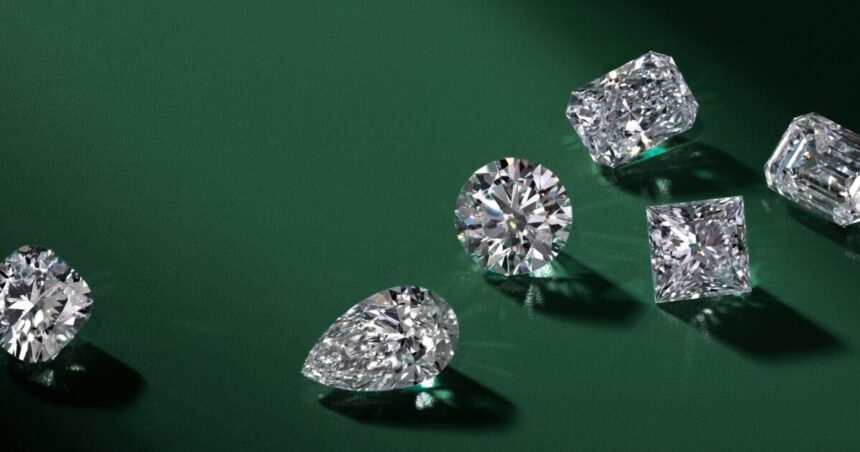In recent years, the ethical and environmental concerns in the diamond and jewellery markets have allowed law-grown diamonds to gain significant traction. Since their inception, they’ve been promoted as the more affordable, sustainable, and eco-friendly choice, but is it really the case? What makes law-grown diamonds more ethical and eco-friendly?
We at Forever Diamonds deal with lab-grown diamonds on a regular basis and incorporate them into many of our pieces, including diamond engagement rings and diamond wedding bands. Based on our experience, we too believe that lab-grown diamonds are the more ethical and eco-friendly choice.
What are lab-grown diamonds?
A ‘lab-grown diamond,’ as the name suggests, is a diamond created in a laboratory setting using advanced technology to emulate the conditions of the earth’s mantle that transforms carbon into diamonds. The primary methods of producing lab-grown diamonds are High Pressure High Temperature (HPHT) and Chemical Vapour Deposition (CVD).
Unfortunately, many mistakenly assume that the diamonds produced by these processes are fake and group them with diamond imitations such as cubic zirconia and moissanite. The diamonds produced by the aforementioned processes are 100% real diamonds that have the same physical, chemical, and optical characteristics as mined diamonds. The only difference between natural and lab-grown diamonds is the price and the process of creation.
Why are lab-grown diamonds more ethical?
There are many reasons why lab-grown diamonds are considered more ethical compared to their naturally mined counterparts:
Conflict-Free
Traditional diamond mining operations, especially in Africa, have been linked to the funding of armed conflicts, and the diamonds that come from these mines are named “blood diamonds.”. By choosing lab-grown diamonds, consumers can rest easy knowing that their money won’t be funding nefarious activities.
Labour Conditions
The diamond mining industry has constantly faced criticism for poor labour conditions. Low wages, unsafe working environments, and exploitation are unfortunately commonplace in mines all over the world. There are even reports of gross human rights violations in the form of child labour and slavery.
Traceability and Transparency
When it comes to lab-grown diamonds, it is a lot easier for consumers to track where they came from. The same level of transparency is difficult to achieve with natural diamonds due to complex and opaque supply chains.
Why Are Lab Diamonds More Eco-Friendly?
When you compare the extent of what is required to extract a single carat of naturally mined diamonds to lab-grown diamonds, it is abundantly clear that lab-grown diamonds are by far the more eco-friendly option.
No Land Disruptions and Habitat Destruction
Since natural diamonds are primarily found in the earth’s mantle, reaching them requires extensive excavations over large areas. These excavations often lead to the degradation of the soil and deforestation that ultimately contributes to the loss of biodiversity. Since lab-grown diamonds are created in controlled environments, there is no need for large-scale disruptions of land.
Reduced Water Consumption
Traditional diamond mining also requires vast amounts of water, with up to 126 gallons of water being needed per carat. At the same time, lab-grown diamonds only require around 18 gallons per carat, making them the more water-efficient choice. The excessive use of water in traditional diamond mining operations often leads to water pollution and scarcity in mining regions.
Lower Carbon Footprint
Traditional diamond mining is extremely energy intensive since it involves the use of heavy machinery, explosives, and large transport vehicles, which in turn increases the carbon footprint of the industry. A study conducted by Clean Origin compared the environmental impact of mined and lab-grown diamonds and found that one carat of natural diamonds equated to 100 square feet of disturbed land and 6000 pounds of mineral waste. The same study also found that one carat of lab-grown diamond only disrupted 0.07 square feet of land and 1 pound of mineral waste.
While lab-grown diamonds also require a lot of energy to produce, it is nowhere near as much as traditional mining. It must be accepted that most lab-diamond-producing countries, such as India and China, rely on burning coal and fossil fuels to produce the electricity needed. However, they and other countries have been transitioning to renewable energy sources, allowing them to further reduce the carbon footprint of lab-grown diamonds.
Conclusion
Lab-grown diamonds are more than just a beautiful choice- it is also a responsible one. We at Forever Diamond believe that luxury should be ethical, sustainable, and transparent. By choosing a diamond ring or wedding band from our stunning lab-grown diamond collection, you’re not only investing in a stunning piece of jewelry, but also making an investment in a greener, more responsible future.






